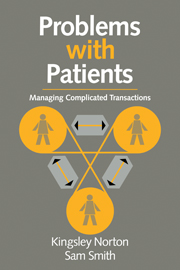Book contents
- Frontmatter
- Contents
- Foreword by Professor Paul Freeling, O.B.E.
- Preface
- Acknowledgments
- 1 Doctor–patient interaction
- 2 The clinical transaction
- 3 Interpersonal influences
- 4 The influence of past relationships
- 5 Contextual influences
- 6 Managing complicated clinical transactions
- 7 Interventions in complicated clinical transactions
- 8 Implications for the clinical setting
- 9 Implications for training
- Appendix I Clinical phenomena related to ‘problem patients’
- Appendix II Personality disorder
- References
- Index
Preface
Published online by Cambridge University Press: 19 March 2010
- Frontmatter
- Contents
- Foreword by Professor Paul Freeling, O.B.E.
- Preface
- Acknowledgments
- 1 Doctor–patient interaction
- 2 The clinical transaction
- 3 Interpersonal influences
- 4 The influence of past relationships
- 5 Contextual influences
- 6 Managing complicated clinical transactions
- 7 Interventions in complicated clinical transactions
- 8 Implications for the clinical setting
- 9 Implications for training
- Appendix I Clinical phenomena related to ‘problem patients’
- Appendix II Personality disorder
- References
- Index
Summary
Certain patients are experienced by doctors as being particularly problematic, irrespective of the diagnosis or the inherent complexities of their medical condition. Somehow, with these individuals, the potentially straightforward process of the consultation and its outcome are adversely affected. Sometimes strong personal feelings are generated in doctor, patient or both. The transaction may become adversarial (even on occasion to the point of violence) with both parties increasingly locked into a stalemate from which clinical concerns are partially or totally excluded. Avoiding such clinically sterile interactions, by preventing the development of complicated clinical transactions, or successfully managing them, is in the interests of patients, doctors and the overall health care system. Doctors working in any clinical setting may be faced with patients whom they label as a ‘difficult’ or ‘problem’ patient. However, the doctor working in primary care is in an especially influential position acting, at least to an extent, as gatekeeper to the secondary tier of health care services. How he or she deals with complicated clinical transactions, and the extent to which such dealings are successful, will also determine how many and which patients are referred to the secondary tier.
Labelling patients as ‘problems’ represents, of course, a doctor-centred view. The real difficulty is more productively construed in terms of the interaction between doctor and patient as they perform their respective roles. This interaction is pursued within the context of the overall doctor–patient relationship, which, particularly in a primary care setting, can extend over many years and gain considerable significance in the lives of doctors and patients alike.
- Type
- Chapter
- Information
- Problems with PatientsManaging Complicated Transactions, pp. xiii - xviPublisher: Cambridge University PressPrint publication year: 1994



